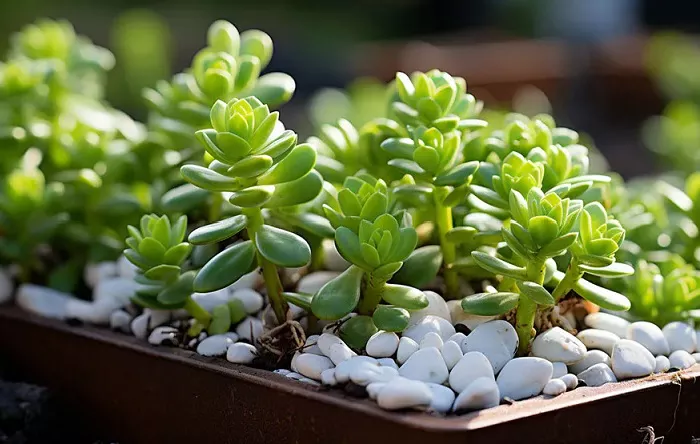Succulents are beloved by gardeners for their hardiness and unique beauty. Whether you’re a seasoned green thumb or a beginner, you might wonder how large your succulent will become. This guide will help you understand the factors that influence succulent growth and how to care for them to reach their full potential.
Understanding Succulent Growth Patterns
Succulents come in a wide variety of shapes and sizes. Some remain small and compact, while others can grow quite large. The ultimate size of a succulent depends on several factors, including its species, growing conditions, and care. For example, a small Echeveria might only reach a few inches in diameter, while an Agave can grow into a massive plant several feet tall and wide. Understanding the natural growth pattern of your specific succulent species is the first step in predicting its size.
The Role of Species in Determining Size
Each succulent species has its own growth characteristics. Some species are naturally small and slow-growing, making them perfect for container gardens or small spaces. Others are fast growers and can quickly fill a large area. For instance, Sedum spurium is a low-growing ground cover that spreads quickly, while Aloe vera is an upright plant that can grow up to two feet tall. When choosing a succulent, consider its mature size to ensure it fits well in your garden or indoor space.
Environmental Factors That Influence Growth
The environment plays a crucial role in how big a succulent will grow. Light, temperature, and humidity all affect its development. Most succulents thrive in bright light, but too much direct sunlight can scorch their leaves. Providing the right balance of light is essential for healthy growth. Temperature also matters; many succulents prefer warm conditions but can tolerate some fluctuations. Additionally, succulents generally do well in low humidity, as high humidity can lead to root rot and other issues.
Soil and Water: The Foundations of Growth
Proper soil and watering practices are fundamental to succulent growth. Succulents need well-draining soil to prevent water from sitting around their roots, which can cause rot. A mix specifically designed for cacti and succulents is ideal. When it comes to watering, it’s important to let the soil dry out between waterings. Overwatering is a common mistake that can stunt growth or even kill the plant. On the other hand, underwatering can also be harmful, so finding the right balance is key.
Pruning and Shaping for Optimal Growth
Pruning can help control the size and shape of your succulent. Removing dead or overgrown leaves can encourage new growth and prevent the plant from becoming too leggy. For example, if you have a trailing succulent like a String of Pearls, you can trim back the long stems to promote bushier growth. Pruning can also help prevent pests and diseases by improving air circulation around the plant.
Container Gardening with Succulents
If you’re growing succulents in containers, the size of the pot will limit their growth. Choose a pot that is appropriate for the mature size of your succulent. A small pot will keep the plant compact, while a larger pot will allow it to grow bigger. However, be careful not to use a pot that is too large, as this can lead to overwatering. When repotting, make sure to use fresh soil and a pot with drainage holes.
Outdoor Succulent Gardens
For those with outdoor gardens, succulents can be a great addition. In the right conditions, they can grow quite large and add a unique touch to your landscape. When planting succulents outdoors, consider the climate and soil conditions of your area. Some succulents can tolerate frost, while others need to be brought indoors during cold weather. Proper spacing is also important to allow for growth and air circulation.
Common Mistakes and How to Avoid Them
Many gardeners make mistakes that can hinder the growth of their succulents. One common error is overwatering, which can lead to root rot and stunted growth. Another mistake is not providing enough light, which can cause the plant to stretch and become weak. To avoid these issues, monitor your succulent’s health closely and adjust its care as needed. Look for signs of stress, such as yellowing leaves or soft stems, and take corrective action promptly.
Tips for Healthy and Robust Succulent Growth
To ensure your succulent reaches its full size potential, follow these tips. First, provide the right growing conditions, including bright light, well-draining soil, and appropriate temperature and humidity levels. Second, water your succulent correctly, allowing the soil to dry out between waterings. Third, prune and shape your succulent to encourage healthy growth and prevent overcrowding. Finally, monitor your plant regularly for signs of pests or disease and address any issues promptly.
Conclusion
Succulents are fascinating plants with a wide range of sizes and growth patterns. By understanding the factors that influence their growth and providing the right care, you can help your succulent reach its full potential. Whether you’re growing a small Echeveria in a pot or a large Agave in your garden, these tips will guide you on your journey to becoming a successful succulent gardener.


